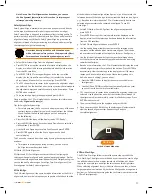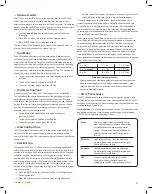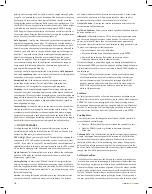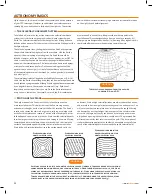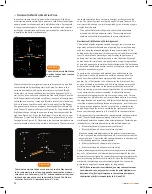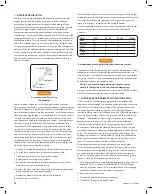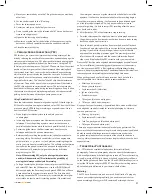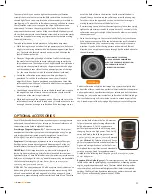
22
>>
www
.celestron
.com
>>
Finding the North Celestial Pole
In each hemisphere, there is a point in the sky around which all the
other stars appear to rotate . These points are called the celestial poles
and are named for the hemisphere in which they reside. For example,
in the northern hemisphere all stars move around the north celestial
pole . When the telescope’s polar axis is pointed at the celestial pole, it
is parallel to the Earth’s rotational axis .
Polaris
(North Star)
Fall
Spring
Summer
Winter
The position of the Big Dipper
changes throughout the year
and the night.
FIGURE 6-5
Many methods of polar alignment require that you know how to find
the celestial pole by identifying stars in the area. For those in the
northern hemisphere, finding the celestial pole is not too difficult.
Fortunately, we have a naked eye star less than a degree away. This
star, Polaris, is the end star in the handle of the Little Dipper . Since the
Little Dipper (technically called Ursa Minor) is not one of the brightest
constellations in the sky, it may be difficult to locate from urban areas.
If this is the case, use the two end stars in the bowl of the Big Dipper
(the pointer stars) . Draw an imaginary line through them toward the
Little Dipper. They point to Polaris (see Figure 6-6). The position of the
Big Dipper changes during the year and throughout the course of the
night (see Figure 6-5). When the Big Dipper is low in the sky (i.e., near
the horizon), it may be difficult to locate. During these times, look for
Cassiopeia (see Figure 6-6). Observers in the southern hemisphere are
not as fortunate as those in the northern hemisphere . The stars around
the south celestial pole are not nearly as bright as those around the
north. The closest star that is relatively bright is Sigma Octantis. This
star is just within naked eye limit (magnitude 5.5) and lies about 59 arc
minutes from the pole .
The north celestial pole is the point in the northern hemisphere
around which all stars appear to rotate. The counterpart in the
southern hemisphere is referred to as the south celestial pole.
Declination Drift Method of Polar Alignment
This method of polar alignment allows you to get the most accurate
alignment on the celestial pole and is required if you want to do long
exposure deep-sky astrophotography through the telescope . The
declination drift method requires that you monitor the drift of selected
stars . The drift of each star tells you how far away the polar axis is
pointing from the true celestial pole and in what direction . Although
declination drift is simple and straight-forward, it requires a great deal
of time and patience to complete when first attempted. The declination
drift method should be done after any one of the previously mentioned
methods has been completed .
To perform the declination drift method you need to choose two
bright stars. One should be near the eastern horizon and one due
south near the meridian . Both stars should be near the celestial
equator (i.e., 0° declination). You will monitor the drift of each star
one at a time and in declination only . While monitoring a star on the
meridian, any misalignment in the east-west direction is revealed .
While monitoring a star near the east/west horizon, any misalignment
in the north-south direction is revealed. It is helpful to have an
illuminated reticle eyepiece to help you recognize any drift. For very
close alignment, a Barlow lens is also recommended since it increases
the magnification and reveals any drift faster. When looking due south,
insert the diagonal so the eyepiece points straight up. Insert the cross
hair eyepiece and align the cross hairs so that one is parallel to the
declination axis and the other is parallel to the right ascension axis .
Move your telescope manually in R .A . and DEC to check parallelism .
First, choose your star near where the celestial equator and the meridian
meet . The star should be approximately within 1/2 an hour of the
meridian and within five degrees of the celestial equator. Center the star
in the field of your telescope and monitor the drift in declination.
• If the star drifts south, the polar axis is too far east.
• If the star drifts north, the polar axis is too far west.
Make the appropriate adjustments to the polar axis to eliminate any
drift. Once you have eliminated all the drift, move to the star near the
eastern horizon . The star should be 20 degrees above the horizon and
within five degrees of the celestial equator.
• If the star drifts south, the polar axis is too low.
• If the star drifts north, the polar axis is too high.
Again, make the appropriate adjustments to the polar axis to eliminate
any drift. Unfortunately, the latter adjustments interact with the prior
adjustments ever so slightly. So, repeat the process again to improve the
accuracy checking both axes for minimal drift. Once the drift has been
eliminated, the telescope is very accurately aligned . You can now do
prime focus deep-sky astrophotography for long periods .
NOTE: If the eastern horizon is blocked, you may choose a star near
the western horizon, but you must reverse the polar high/low error
directions. Also, if using this method in the southern hemisphere,
the direction of drift is reversed for both R.A. and DEC.
Polaris
(North Star)
Big Dipper
Little Dipper
Cassiopeia
N.C.P.
Poin
ter S
tars
FIGURE 6-6
The two stars in the front of the bowl of the Big Dipper point
to Polaris which is less than one degree from the true (north)
celestial pole. Cassiopeia, the “W” shaped constellation, is on
the opposite side of the pole from the Big Dipper. The North
Celestial Pole (N.C.P.) is marked by the “+” sign.
Содержание 11007
Страница 1: ...InstructionManual 11007 11008 11009...
Страница 2: ...www celestron com...
Страница 40: ...38 www celestron com APPENDIXD MAPSOFTIMEZONES...
Страница 41: ...www celestron com 39...
Страница 42: ...40 www celestron com APPENDIXE SKYMAPS...
Страница 43: ...www celestron com 41...
Страница 44: ...42 www celestron com...
Страница 45: ...www celestron com 43...
Страница 46: ...44 www celestron com...
Страница 47: ...www celestron com 45...




